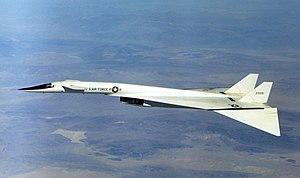| XB-70 Valkyrie | |
|---|---|
 XB-70 Valkyrie in flight | |
| General information | |
| Type | Strategic bomber Supersonic research aircraft |
| National origin | United States |
| Manufacturer | North American Aviation (NAA) |
| Status | Retired |
| Primary users | United States Air Force |
| Number built | 2 |
| History | |
| First flight | 21 September 1964 |
| Retired | 4 February 1969 |
The North American Aviation XB-70 Valkyrie is a retired prototype version of the planned B-70 nuclear-armed, deep-penetration supersonic strategic bomber for the United States Air Force Strategic Air Command. Designed in the late 1950s by North American Aviation (NAA) to replace the B-52 Stratofortress and B-58 Hustler,[1] the six-engined, delta-winged Valkyrie[2] could cruise for thousands of miles at Mach 3+ while flying at 70,000 feet (21,000 m).
At these speeds, it was expected that the B-70 would be practically immune to interceptor aircraft, the only effective weapon against bomber aircraft at the time. The bomber would spend only a brief time over a particular radar station, flying out of its range before the controllers could position their fighters in a suitable location for an interception. Its high speed made the aircraft difficult to see on radar displays and its high-altitude and high-speed capabilities could not be matched by any contemporaneous Soviet interceptor or fighter aircraft.
The introduction of the first Soviet surface-to-air missiles in the late 1950s put the near-invulnerability of the B-70 in doubt. In response, the Air Force began flying its missions at low level, where the missile radar's line of sight was limited by terrain. In this low-level penetration role, the B-70 offered little additional performance over the B-52 it was meant to replace, while being far more expensive with shorter range. Alternative missions were proposed, but these were of limited scope. With the advent of intercontinental ballistic missiles (ICBMs) during the late 1950s, crewed nuclear bombers were increasingly seen as obsolete.
The USAF eventually gave up fighting for its production and the B-70 program was cancelled in 1961. Development was then turned over to a research program to study the effects of long-duration high-speed flight. As a result, two prototype aircraft, designated XB-70As, were built; these aircraft were used for supersonic test-flights from 1964 to 1969. In 1966, one prototype crashed after colliding with a smaller aircraft while flying in close formation; the remaining Valkyrie bomber is in the National Museum of the United States Air Force near Dayton, Ohio.
- ^ The World's Fastest Bomber: The XB-70 Valkyrie, 31 March 2022, archived from the original on 22 January 2024, retrieved 23 January 2024
- ^ Jane's all the World's Aircraft 1963-1964, p. 254.